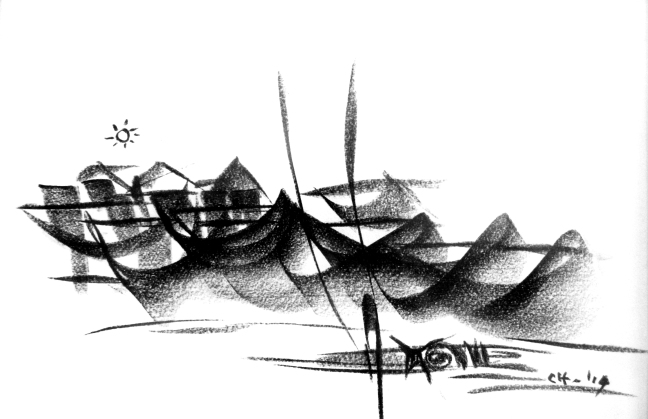 Small air, burning wood; and charcoal is formed. In July 2014, an exhibition of drawings made of charcoal opened in Enugu State, Nigeria. The exhibition titled Akala Unyi is the solo show by Chijioke Onuora, an alumnus of the University of Nigeria Nsukka who has been quiet on the art scene for about a decade. He first specialized in sculpture and presently takes drawing classes in the school popularly referred to as the Nsukka School with its associations with the pioneering efforts of Professor Uche Okeke’s experimentation with Uli, a native drawing style.
Small air, burning wood; and charcoal is formed. In July 2014, an exhibition of drawings made of charcoal opened in Enugu State, Nigeria. The exhibition titled Akala Unyi is the solo show by Chijioke Onuora, an alumnus of the University of Nigeria Nsukka who has been quiet on the art scene for about a decade. He first specialized in sculpture and presently takes drawing classes in the school popularly referred to as the Nsukka School with its associations with the pioneering efforts of Professor Uche Okeke’s experimentation with Uli, a native drawing style.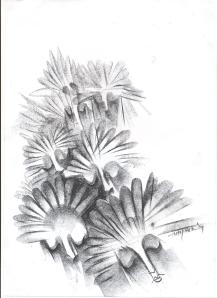
If lines made a School of Art, then Nsukka is it. Line and space have remained the predominant elements of art since inception of the school. From the vegetal, whirlwind strokes of Uche Okeke, through the lyrical, sinuous and passionate lines of Chike Aniakor, the ordered sectioning of Obiora Udechukwu; to the raging, antagonistic vigour found in the younger crop of artists who emerged from Nsukka-Chika Okeke-Agulu, Olu Oguibe, and further down to George Odoh, Uche Edochie( the writer includes the few artists from the School whose works are familiar, of course there have been other great draughtsmen in Nsukka), Nsukka and the Uli School has remained a strong force for the lyrical line. Of note is Seth Anku, the late Ghanian sculptor,lecturer who worked in Nsukka till his death a few years ago. Chijioke Onuora worked under him and assisted Seth Anku in executing fountain sculptures. Seth Anku’s mastery of the charcoal medium is arguably unparalleled amongst the artists from Nsukka. Chijioke Onuora has, in interviews in the past, acknowledged him as mentor and inspiration, who taught him how to handle the charcoal medium. Those unfamiliar with the training at Nsukka wrongfully mistake the bulk of the conceptual work produced from that art tradition as being a sign of some escapist ineptitude in drawing. We were vigorously trained as draughtsmen. A closer reading of the works of Nsukka artists will show a strong understanding in the use of form, space, line and space. Ignoring drawing would be tantamount to removing the skeleton from anatomy lessons. I insist that even the most inefficient, albeit famous artists (as draughtsmen) have shown, through their works, an intuitive sense of space located inside of lines and form. In the end, lines rule.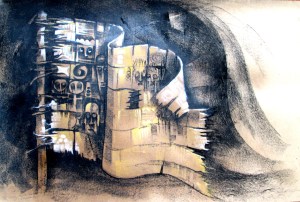
Excuse me, Art is play. Chijioke Onuora’s drawings observe the three dimensionality of things, and records whirls of atmospheric contours to evoke things. The works in the exhibition thrive between the caricatured, the satirical, and traditional Igbo lore. He draws from nature, and retranslates it with turgid force into soft, translucent form. His is an informed, humanist, sympathetic vision that deifies and edifies, while uplifting the audience. He is that strong force that is spelled genius, and yet, like the humble reed, knows when to bow. There is no obstruction in assessing the meaning or content of his work. Watching him work is an education in drawing. One does not see the beginning of the process as following some planned direction. One only witnesses to the monumental, finished work. The creative process thus remains mysterious. Chijioke Onuora’s exhibition titled Akala Unyi is a landmark achievement in the annals of Nsukka’s art-history, one to be documented and retold for years.
Dr Chijioke Onuora was made a lecturer in 1994. He was my lecturer for most of the drawing classes. This was at the same time when we had Professor Chike Aniakor giving painting classes, and gushing over the beauty of the lyrical line. In those charged years of our budding, the students blossomed under some of the most creative spirits ever to pass through Nsukka-there was El Anatsui, Obiora Udechukwu, Chike Aniakor, Chika Okeke-Agulu and so on. The air was full of fire and smoke from wars with the campus authorities, and of students’ unionism against the unpopular military regime of the time. The campus was closed briefly for one of those students’ riots that were happening, and echoed in other campuses across Nigeria at the time. Through the intermittent halts or closure and openings, we got an education, somehow. We also had an inkling of the kind of society and government we would be walking into-an uneasy place. The school certificate will do little in opening doors.
Tuff Studio on Catherine Rest House road was a walking distance from Zik’s Halls Flats, then residence of first year students of the University of Nigeria, Nsukka. There was also House of Hunger, Olu Oguibe’s (later inherited by Chika Okeke-Agulu) studio. Gbugbemi Amas lived with his family further down the road. He was a contemporary of Chijioke Onuora’s. Amas made it a point of duty to occasionally visit the undergraduate school and tear down our illusions about the benefits of the learning we were receiving at the time. He was a wildcard, Amas was. There were other radical elements in Nsukka too, who had a more direct influence on the Fine and Applied Arts students. Chika Okeke-Agulu was appointed lecturer at Nsukka at about the same time with Chijioke Onuora. In those days, his classes seemed to be designed to either break or boost us students. He well understood that these were the best years of a young artist’s life, before reality sets in. We may as well be stopped on our tracks now, than go out with foggy dreams about Art and Society. Apart from the exciting stimulations from such brilliant minds, undergraduate students faced the plight of mismanaging the funds received from their parents/sponsors.
Chijioke Onuora sort of fits into the mix, offering the balm or soft landing we needed. His Tuff Studio was the place for the student who wanted to work without unwanted interference and could not afford to pay for renting studio space outside the campus. It was also the place to find traumatised students mourning from the brunt coming from the space called Nsukka in the nineties. Then, Dr Nnamdi Azikiwe lived at his residence beside Zik’s Flats, and still played table-tennis even in his old age with his young friend Dr Ben Okwuosa.
Nsukka lived up to its billing as a high-class environment for raising leaders and innovators in their professional fields. Tuff Studio created the soft landing. Chijioke Onuora kept a room in front. The theme music for the studio was reggae, and old jazz. Louis Armstrong was an unforgettable favourite. I am one of the few students who moved between Tuff and House of Hunger studios, whose masters seemed at pole ends in terms of world view, etc., albeit that they were contemporaries.
Consistently, and at various group exhibitions, Chijioke Onuora has shown charcoal drawings. His understanding of the medium, its nuances from soft to hard, brutal to silent halts is inspirational. The negative spaces (places or silent planes were the artist leaves bare) create a powerful balance to the composition. Again and again, this happens in charcoal drawings. Charcoal drawings discard of the pleasantry of slow, smooth transitions. It is the medium that transmits Chijioke Onuora’s bubbly spirit, deeply hidden under mildness and humour. Art will always make the human spirit soar.
The act of working in the medium is in itself intimate, innocuous and immediate. Charcoal has a way of soiling, crumbling and blending that causes a mild furor with the artist using it. There can be told tales of many fireside exchanges, of waiting at mother’s kitchen for the meal to be cooked; of staring hungrily as the orange flames lick the wood black. The scene could be continued after eating a tasty meal, and being given the task of dispersing the fire, quenching the flames so that the residue wood can be used on another day. The burnt wood forms a hard charcoal, and is malleable enough to leave marks on almost any surface it meets. Of course, Chijioke Onuora adds his personal story of introduction to the medium, way back in early innocence.
Having majored in Sculpture when all the tradition and training was dominantly about forming wood carvers, Onuorah understands the medium well. He has chipped, splintered, and burned enough wood. It is easier for the wood carver to pick up charcoal sticks from the hearth to make sketches. His Ph.D dissertation was about pyrography (the wood burning technique made famous in Nsukka by El Anatsui).
Nsukka has seen decades of enjoying Osky’s (as he is fondly called) classes in Drawing. He has used the medium to challenge undergraduate students in seeing, translating and transmitting idea. He has organized and held several drawing exhibitions with students. For him, the lyrical lines of charcoal never seize to mesmerize, to cajole. Chijioke Onuorah’s masterly strokes render realistic forms as beautifully as when he marks the surface of white paper with symbols from uli and nsibidi. Built like a wrestler with the heart of a teddy bear, the man is the artist’s friend, an artist as muse.
Akala Unyi, this major solo exhibition at the once-gloriously named Coal city comes at a time when Nigeria revisits the coal industry. A publication in The Guardian newspaper (14th September, 2014) discusses the consumption plan for coal in Nigeria. Whatever the story is about coal, the Coal City (as Enugu is popularly known) came abuzz in celebrating a more economical use of the substance. The well-attended show came with the publication of an exhibition catalogue profuse with writings by friends and acquaintances of the artist who present various angles-from character portraits, stories, to essays on Drawing. All this is well, and in celebration of a man who has done it more consistently and with so much passion. Chijioke Onuora has etched a name in gold at the mention of drawing in Nsukka. Drawing comes at the cradle, but will always form the underlying base for most artistic expressions. It is a forever-living art form, and can powerfully evoke and accommodate the translation of ideas. There is the fear of durability-how long will the work drawn in charcoal last? The bottom-line is that the artwork has an independent life span, independent of physical elemental paradigms of time. If it is remembered only as memory, it still thrives. The importance of the artwork will ultimately remain the fact of its formation, first and foremost.
Time was when charcoal drawing or sketching was of utmost importance to all sculptors, nay, to all artists. In understanding the work, one should get familiar with its formative stages. Lines don’t lie.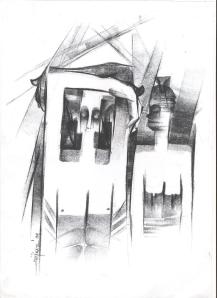
Telling Lines
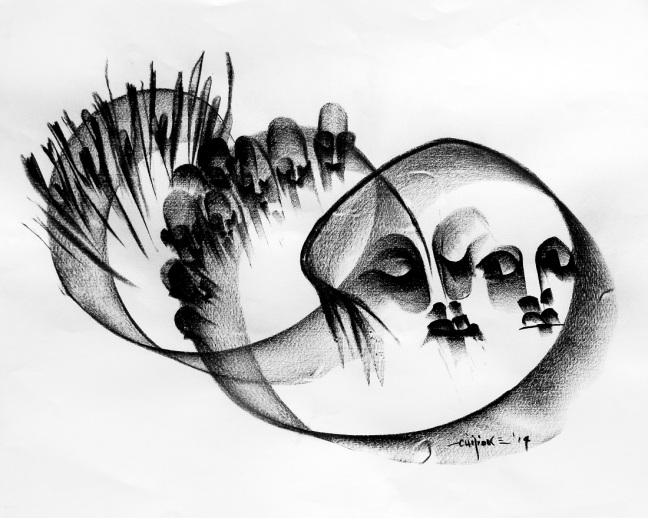
Hello! Sorry this comment is not about your blogpost, about about your painting, Jael, Heber’s Wife. I am a professor and scholar, writing a book about artistic renditions of Jael and am interesting in learning more about yours. Please let me know if you’re willing to answer few questions about this fascinating painting. Many thanks.
LikeLike